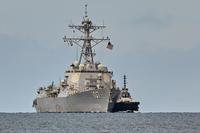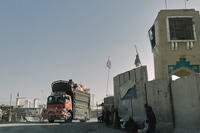A newly released Navy investigation into drinking water contamination aboard two aircraft carriers last fall found the problem stemmed from aging systems on the ships.
But the investigation also found the incidents of contamination with E. coli and jet fuel were exacerbated by actions of crew members and policies that were unprepared to deal with contamination, particularly fuel, entering the water supply.
The pair of incidents -- though unconnected -- happened within days of each other aboard the aircraft carriers USS Nimitz and USS Abraham Lincoln off the coast of southern California in September 2022. In both cases, the initial reports of issues came from social media posts rather than Navy statements.
Read Next: Republicans Vow to Boost Veteran Spending Amid Debt Ceiling Fight
Although the Navy insists that the E. coli contamination aboard the Lincoln led to no reported issues, the service said 11 sailors aboard the Nimitz had symptoms that may have been caused by ingesting jet fuel that got into that carrier's water, though all were eventually cleared to return to duty.
In the first incident aboard the USS Nimitz, the Navy's investigation confirmed earlier admissions by the service that jet fuel had made its way into the ship's water supply.
However, the investigation revealed that the source of the jet fuel was not a leak but rather the result of crew members trying to work on a handful of the 26 potable water tanks aboard the ship that had been out of service.
Unbeknownst to the crew, one of the out-of-service tanks held JP-5 -- jet fuel -- that leaked into the tank during the ship's last deployment in 2021 through a deteriorated cover, according to the investigation.
However, it appears that that detail was forgotten or not properly noted, because by 2022 "informal records indicated [the tank] contained a mixture of potable water and seawater" and investigators found that "the ship did not know or consider the possibility that the tank might contain contaminants other than seawater."
The crew's plan was to clean the potable water system by flushing the piping and pump with clean water. It appears that the plan allowed for the jet fuel to make it into the rest of the ship through shared piping.
Since the Navy redacted all references that identified the specific tanks investigators were referring to, it is difficult to understand some specific sequences and events laid out in the report.
On Sept. 16, between noon and 3 p.m., as the crew was pumping water from one of the potable tanks, they noticed an odor of JP-5, according to the Navy investigation. Despite isolating some of the tanks and pumps and flushing sections of the system, at around 9 p.m. the engineering control hub on the ship started getting reports from the wardroom, staterooms and crew quarters that there was fuel in the water.
The report does praise the leadership of the ship for taking quick action once the problem was identified. Investigators found that it took about 30 minutes to shut off water service to the ship and 90 minutes for Capt. Craig Sicola to begin addressing the crew.
The report said that Sicola unequivocally told the crew not to use the ship's water.
However, the incident also revealed that Navy ships are not set up to deal with fuel contamination. The report noted that the crew "does not have capability or procedures to analyze water or [sewage] to determine the presence or concentration of JP-5" and "neither the ship nor shore support facilities had pre-planned procedures or response actions to recover a shipboard potable water system contaminated with JP-5."
As a result, testing had to be done by an outside laboratory, and samples from 12 onboard tanks showed the presence of hydrocarbons -- the broad term for compounds that include jet fuel -- that ranged from undetectable to as high as 4.9 parts per million.
The report says the Navy's limit, based on an Environmental Protection Agency analysis, is only 0.266 parts per million.
Although the ship was aided by the fact that it was able to pull into San Diego the day after the contamination was discovered, it still took the rest of September to remove all of the fuel contamination. On Oct. 1, the ship's water system was deemed usable again.
In contrast to the Nimitz, the sailors on the Lincoln faced a different contamination -- the bacteria E. coli. Furthermore, the incident aboard could have been prevented had the crew been more aggressive in identifying the issue.
Like the Nimitz, the Lincoln had a water tank that developed a hole from rust, which allowed contaminants to seep in. Unlike the Nimitz, the tank was in service. On Sept. 17, the day before the ship was to set sail, the tank "experienced an unaccounted for change in level" that added about 2,000 gallons, according to the report.
The extra liquid came from the bilge -- a system of voids and spaces under a ship's equipment that often collects substances like jet fuel and oil and functions as a kind of sewer for the ship.
The next day, Sept. 18, a crew member noted the higher than normal level but assumed it was extra water from the pier and did nothing.
Three days later, around noon on Sept. 21, the ship started using water from the tank; almost immediately, a sailor reported to a superior that the water had a "weird" taste. That superior did not report the issue further.
In all, investigators said there were four missed opportunities for watch standers to identify and flag the water contamination before it spread throughout the ship.
"Basic watchstanding principles would have prevented or minimized the spread of the contaminated water in this case," they noted.
In fact, reports kept coming in throughout the evening, but actions by the engineering staff did little. At around 9 p.m., the contaminated tank was even reintroduced back into service after being taken offline earlier in the day.
At 10 p.m., almost 12 hours after the first report of foul water, the ship's executive officer, Capt. Patrick Baker, was told there might be an issue. "Around this time, [Baker] noticed a run on the bottled water at the ship's store," the report also noted.
According to the report, although Baker then briefed the commanding officer, Capt. Amy Bauernschmidt, the decision was made for her to make an announcement to the crew the next morning. In the meantime, the crew started dosing the water with extra chlorine and taking samples for testing.
The next day, Sept. 22, tests revealed bacterial contamination, including E. coli, in seven samples.
Several undated videos of Bauernschmidt addressing the crew were eventually posted online. In one video, seemingly shot after the confirmation of the contamination, Bauernschmidt tells her crew "before anybody starts freaking out ... E. coli is an extremely common bacteria."
"Matter of fact, every single person on this ship has it in their digestive system right now," the captain said while sailors captured in the video listening to the announcement can be heard in the background loudly protesting, "That's not how that works!"
In another video, she says that she had in front of her a bottle "of exactly what everyone was talking about" before immediately explaining that she purposely took a shower the night before and explained that it was "marvelous."
"I even tasted the water," she said before explaining it was "good to go."
The report does not shed any more light on the remarks but does say that Baker had a meeting on Sept. 22 with the ship's doctor, chief engineer and other leaders to discuss a plan.
Military.com reported that the Navy declared the ship's contamination solved a month later. However, given the results of the investigation of the Nimitz, which found that ships cannot test for substances like fuel that often find their way into bilge water, it is still unclear whether the crew was exposed to other substances beyond E. coli. Unlike the Nimitz, the Lincoln's investigation makes no mention of samples being sent off to an outside lab for testing.
The report also notes that the Lincoln's response was hampered by several factors.
The crew didn't dwell on reports of five tanks having bacterial contamination from January through March 2022. Investigators said no other carrier had a drinking water tank test positive for bacteria in the past two years.
"This should have been a warning sign," they concluded.
Investigators also faulted the tests that the Navy uses as "not timely enough to support emergent decision-making" since they need 18 hours to incubate to be useful.
Finally, the ship's equipment for adding chlorine straight to the water supply was not working at the time. "If [it] had been present and online, they would have significantly mitigated this issue," the report notes.
Neither report suggests punitive measures for anyone associated with either incident. In fact, Bauernschmidt has since been recommended for promotion to rear admiral.
In a letter signing off on the investigations, Vice Adm. Kenneth Whitesell, the head of naval aviation, noted that he stood up an "Aircraft Carrier Potable Water Working Group" in November 2022 to review all the drinking water incidents from the prior year to help address future incidents. That working group should have made its final recommendations at the end of January, but it does not appear the Navy has made those public.
-- Konstantin Toropin can be reached at konstantin.toropin@military.com. Follow him on Twitter @ktoropin.













